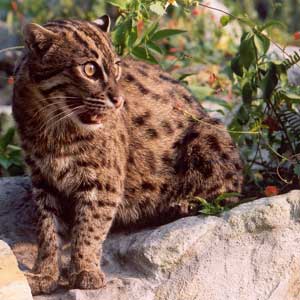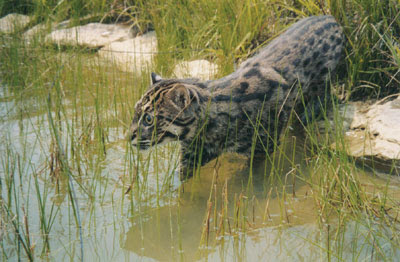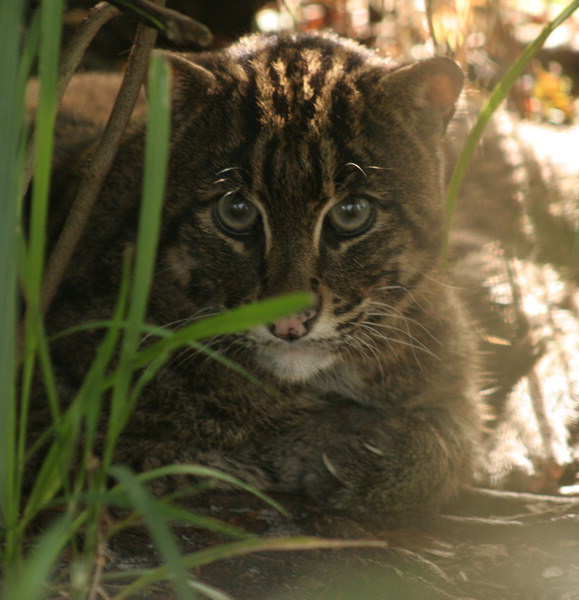
Fishing Cat
The Fishing Cat (Prionailurus viverrinus) is a medium-sized cat whose disjunct global range extends from eastern Pakistan through portions of India, Nepal and Sri Lanka, throughout Bangladesh and Mainland Southeast Asia to Sumatra and Java. Its fur has an olive-grey color and dark spots roughly arranged in longitudinal stripes. The face has a distinctly flat-nosed appearance. The size is variable; while in India it is 80 cm, or 32 in, (and 30 cm, 12 in, tail), in Indonesia, it is only 65 cm, or 26 in, (25 cm, 10 in, tail). Indian individuals usually range up to 11.7 kg (26 lbs), while in Indonesia common weights are approximately 6 kg (13 lbs). They are stocky of build with medium short legs, and a short muscular tail of one half to one third of their head and body length.
Like its closest relative, the Leopard Cat, the Fishing Cat lives along rivers, brooks and mangrove swamps. It is perhaps better adapted to this habitat, since it swims often and skillfully.
Like its closest relative, the Leopard Cat, the Fishing Cat lives along rivers, brooks and mangrove swamps. It is perhaps better adapted to this habitat, since it swims often and skillfully.

As the name implies, fish is the main prey of this cat, of which it hunts about 10 different species. It also hunts other aquatic animals such as frogs or crayfish, and terrestrial animals such as rodents and birds. The inter-digital webs on its paws help the cat gain better traction in muddy environments and water, like other mammals in semi-aquatic environments.
The Fishing Cat is endangered due to its dependance on wetlands, which are increasingly being settled and converted for agriculture, and also due to human overexploitation of local fish stocks. It is believed extinct in Afghanistan, may already be gone from Malaysia and China, and has become rare throughout its remaining distribution.
Captive Fishing Cats can be seen at 22 different North American institutions. By December 2005, there were 72 Fishing Cats in these institutions.
The Fishing Cat is endangered due to its dependance on wetlands, which are increasingly being settled and converted for agriculture, and also due to human overexploitation of local fish stocks. It is believed extinct in Afghanistan, may already be gone from Malaysia and China, and has become rare throughout its remaining distribution.
Captive Fishing Cats can be seen at 22 different North American institutions. By December 2005, there were 72 Fishing Cats in these institutions.






















Fishing Cat

My favorite is the last photo!
ReplyDelete